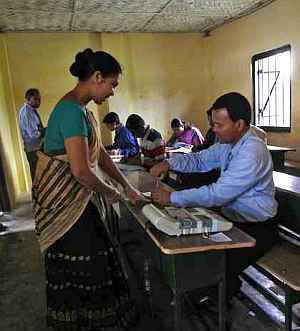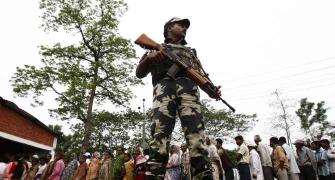 ‘The failure of the ECI to follow the Registration of Electoral Rules and create verified and audited rolls or even verifiable and auditable ones, highlight that the entire electoral roll is merely a compilation of names without any effort or intention for completeness, correctness or fair play.’
‘The failure of the ECI to follow the Registration of Electoral Rules and create verified and audited rolls or even verifiable and auditable ones, highlight that the entire electoral roll is merely a compilation of names without any effort or intention for completeness, correctness or fair play.’
‘We are fooling ourselves by electing our representatives based on faulty electoral rolls that do not represent the people of the constituency. Elections based on these rolls are neither free nor fair. Democracy is under siege,’ says Dr Anupam Saraph.
There is no verified and audited copy of the electoral rolls with anyone.
Electoral rolls for a parliamentary constituency include all the rolls of the assembly constituencies within the PC. Each AC roll has about 300 parts, each of which has about 1,500 persons listed. None of these parts is verifiable or auditable.
According to Rule 6 of the Registration of Electors Rules, the electoral rolls should have been alphabetically displayed like in a phone book or arranged by house numbers for easy spotting of missing names and duplicates or suspicious entries.
In practice, the names are randomly distributed across and within parts of the electoral roll. That is precisely why you had trouble finding your name on the printed rolls or identifying the “part” to which your name belonged in order to locate your polling centre and within it the booth where you needed to cast your vote.
More importantly, that is why you can never tell if this is a complete list of voters from your neighbourhood or even a genuine one.
Rule 25 of the Registration of Electors Rules requires an intensive revision of the rolls and requires that rules 4 to 23 be applied in such revision as they would apply in relation to the first preparation of a roll.
When such a revision takes place, the corrected papers have to be kept in the office of the registration officer until the expiration of one year after the next intensive revision of that roll. Every person has the right to inspect the election papers referred to in rule 32 and to get attested copies.
No such papers exist as no intensive revision of the rolls has happened.
In September 2011, the Election Commission of India had asked for the block-level registers (ie, registers containing details of all the electors in the block) be updated through door-to-door visits. No such visit ever happened.
The block-level registers were not available for inspection despite repeated requests to the election offices. If block-level registers are not updated, it implies that addresses and persons on the roll may not exist, or that addresses and persons that exist may not be on the roll.
With complete disregard to the conflict of interest of political parties in the matter, the district election offices outsourced the task of submitting forms for addition (form 6) and deletion (form 7 and 8A) of names to political parties in order to produce an amended copy of the existing roll (also called as summary revision).
This made possible selective addition of those favourable to the party as also the selective removal of those unfavourable to the party easy. It also made possible the addition of dummy voters to allow for fake voting and double voting easy.
To add insult to injury, the district election offices accepted such forms in bulk without scrutiny or verification. It is no surprise, therefore, that all irregularities would creep into electoral rolls.
Electoral rolls prepared with such irregularities fraudulently interfere with the process of an election whereby members of a party can occupy a polling booth, excluding and voting in place of those people who should be able to vote there. This is booth-capturing as described in section 135A of the Representation of the People Act of 1951.
The Election Commission of India also permitted the use of Aadhaar cards as a proof of identity and proof of address. Aadhaar is a random number assigned to unverified and unaudited data submitted by private parties. It is not a proof of identity or address; not even a proof of existence. It certainly is not a proof of citizenship. Not even the UIDAI certifies it as such.
This means that in one stroke the ECI allowed the registration of residents with different identities, residents of another location, non-existing persons and even non-citizens.
It also opened up the possibility of multiple registrations by the same persons or even registration at locations other than where they belong and with multiple IDs.
To make matters worse, netas or their agents doing bulk submission of form 6 and 7 to add or delete names were also enrolment agents and introducers for Aadhaar.
This made it possible and easy to create persons with similar identities in different locations to allow for fake or duplicate voting.
It also made it possible and easy for such netas or their agents to submit forms on behalf and without the knowledge of those who did Aadhaar registration with them.
It is possible and easy to doctor the roll to favour the neta by moving people across constituencies, adding or deleting persons.
The task of creating rolls from the data entered by election staffers into the electoral roll management system was outsourced to by the ECI to Aatishay Infotech, a Bhopal-based IT company also working on Aadhaar enrolment.
As there is no verification or audit of the roll, or transparency of the role of Aatishay Infotech in the entire process, it is easily possible that not all persons submitting form 6 may have been included, as also persons may be deleted without submitting form 7 -- or even that not all persons or addresses may actually exist.
Strangely, the ERMS prints selective information and incomplete addresses on the roll and EPIC.
It has been widely reported and observed and is easily verifiable by downloading a PDF copy of any roll, that addresses are incomplete and therefore untraceable.
This makes persons on the roll or with EPIC untraceable.
It makes it impossible to audit the rolls. It is possible for persons to impersonate another, by claiming error in the information on the roll.
Under the Registration of Electors Rules, rolls and connected papers shall be kept in the office of the election registration officer until the expiration of one year after the next intensive revision (or creating such rolls afresh) of that roll.
No papers are ever available with the ERO as intensive revision is a rare event. It is difficult, at best, to trace how the names got into or out of the roll.
In the absence of any verifiable or auditable rolls, how can one estimate the extent of the damage?
If you calculate the number of people who would be expected to be on the roll given the age structure as published by the Census of India and the population of a constituency as published by the Maharashtra State Election Commission, you would get the table below.

This shows that there are at least 35 pc non-existent voters.
Add to that if 25 pc of the existing electors are deleted, as is apparent from the PDF lists found pm the ECI website, the electoral rolls are off by at least off by a whopping 60 pc.
This has been brought to the attention of the election machinery from 2011.
In fact, activists from Pune took objections to the entire electoral roll as far back as on voters day, January 25, in 2012 with the district election officer in Pune. The district election office has not even undertaken an inquiry as required under Rule 20 of the Registration of Electors Rules. The complaint lodged with the then commissioner of police has also not progressed.
The elections to Parliament have not happened on new, intensively revised rolls. Rather, there have been more additions and deletions through political parties. The roll is therefore expected to have an even larger mismatch in being representative of any constituency.
If the Representation of the People Act cannot cause the people to be represented, what can?
The writing on the wall is clear. We are not the largest democracy as we have claimed ourselves to be, we only appear to be a democracy.
Our netas have lost perspective of what democracy is all about and have come to represent elections and the formation of local bodies, legislative bodies or Parliament as democracy.
Our administration has come to believe that the netas are their bosses, not the people.
We are made to believe that elections are the only way we can participate in the democratic process.
So why worry?
The failure of the ECI to follow the Registration of Electoral Rules and create verified and audited rolls or even verifiable and auditable ones, highlight that the entire electoral roll is merely a compilation of names without any effort or intention for completeness, correctness or fair play.
We are fooling ourselves by electing our representatives based on faulty electoral rolls that do not represent the people of the constituency. Elections based on these rolls are neither free nor fair. Democracy is under siege.
The ECI continues to use unverified and unaudited electoral rolls and fails to have any audit to certify all who voted were eligible or all who were eligible were on the rolls.
The ECI creates the rolls, conducts the election, declares it to be free and fair and also rules on any objections of the process.
The Preamble to the Constitution guarantees us justice. Where can the aam aadmi get justice if the ECI uses Section 329 of the Representation of the People Act to prevent the courts from “interfering”?
Will the courts strike down Section 329 under Article 13 of the Constitution that strikes down laws inconsistent with or in derogation of Fundamental Rights?
Especially since the entire mockery of election process has compromised the people’s right to Freedom of Speech under Article 19 of the Constitution, apart from declaring as unequal all those whose opinion will no longer be counted and thus violating Article 14.
It is clear that the ECI must undertake an intensive revision of the electoral rolls through door-to-door visits by staff that is hired solely for this purpose. With publicly accessible online maps, it should be easy to number each part of the roll and each house on each street for complete transparency.
It is not impossible to mail a two-part bar-coded postcard to the electors at each address once the door-to-door surveys are completed, which they would be required to mail back with their signature to confirm their address.
It is not too much to require the Comptroller and Auditor General to audit the rolls for their compliance with Rule 6 of the Registration of Electors Rules, for completeness, correctness and fairness.
It certainly is not asking for too much to require the conduct of free and fair elections as soon as, and only after, such genuine, verified and audited electoral rolls are available.
Dr Anupam Saraph has researched Indian elections since 2009 and has submitted detailed reports on election reforms to the ministry of law and justice and the Election Commission of India. He is also a member of the Nagrik Chetna Manch that has raised this issue with the Chief Justice of India and the Election Commission of India.









